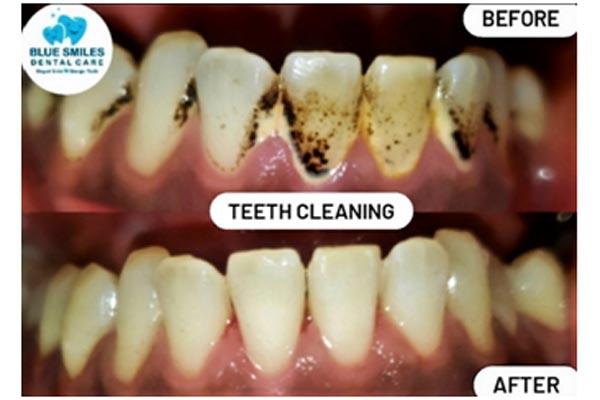Scaling of teeth is a dental procedure in which tartar (calculus) and plaque deposits are removed from the surface of the teeth and below the gum line. This helps to prevent gum disease and tooth decay, which can cause serious health problems if left untreated.
Scaling can be performed using manual instruments, such as scalers, or with ultrasonic instruments, which use high-frequency vibration to remove deposits. The procedure is usually performed by a dental hygienist or dentist and may require local anesthesia, especially if scaling is needed below the gum line.
Scaling is a routine part of dental hygiene and is typically performed once or twice a year, depending on the individual’s needs. Good oral hygiene practices, such as brushing and flossing, can help prevent the buildup of plaque and tartar, reducing the need for scaling.
If you have questions about scaling or your oral health, it’s best to consult a dentist or dental hygienist. They can examine your teeth and gums and recommend the best course of treatment for your individual needs.
- Procedure of teeth scaling
The procedure for scaling teeth typically involves the following steps:
- Inspection: The dentist or dental hygienist will examine your teeth and gums to assess the extent of plaque and tartar buildup. They may also take X-rays to get a better look at the roots of the teeth and surrounding bone.
- Cleaning: The dentist or dental hygienist will then use manual or ultrasonic instruments to remove the plaque and tartar deposits. For manual scaling, they may use a scaler to gently scrape away the deposits. For ultrasonic scaling, they will use a hand-held device that emits high-frequency vibrations to break up the deposits, which can then be suctioned away.
- Polishing: After the scaling, the dentist or dental hygienist will polish the teeth to smooth any rough spots that can attract future plaque buildup. They may use a special toothpaste and a rotating brush for this step.
- Review: The dentist or dental hygienist will review their findings with you and discuss any recommendations for maintaining good oral hygiene between visits. They may also discuss any additional treatments that may be necessary, such as fillings or gum treatments.
The scaling procedure is typically performed under local anesthesia, which numbs the gums and teeth, so that the patient experiences minimal discomfort. The entire procedure usually takes 30 to 60 minutes, depending on the extent of the plaque and tartar buildup.
It’s important to maintain good oral hygiene after the scaling procedure by brushing and flossing regularly, as well as scheduling regular dental check-ups and cleanings. This can help prevent future plaque and tartar buildup and maintain good oral health.
- Pros and cons of dental scaling
Here are some of the pros and cons of dental scaling:
Pros:
- Improved oral health: Scaling can remove plaque and tartar that can cause gum disease and tooth decay. By removing these deposits, scaling can help prevent the progression of gum disease and tooth decay, and improve oral health.
- Fresh breath: Plaque and tartar can cause bad breath, and scaling can remove these deposits, resulting in fresher breath.
- Better aesthetics: Plaque and tartar buildup can discolor teeth and make them appear yellow or brown. Scaling can remove these deposits and improve the appearance of teeth.
- Early detection of oral problems: During the scaling procedure, the dentist or dental hygienist can detect early signs of oral problems, such as cavities or gum disease, and provide prompt treatment.
Cons:
- Discomfort: Scaling can be uncomfortable, especially if it is performed below the gum line. Some patients may experience sensitivity or tenderness in the gums after the procedure.
- Time commitment: Scaling can take anywhere from 30 minutes to an hour, and may require multiple visits, depending on the extent of the plaque and tartar buildup.
- Cost: Scaling is a dental procedure and may not be covered by insurance. The cost can vary depending on the extent of the plaque and tartar buildup and the type of scaling performed (manual or ultrasonic).
- Temporary sensitivity: Some patients may experience temporary sensitivity or tenderness in the gums or teeth after the scaling procedure.
It’s important to weigh the pros and cons of dental scaling before deciding whether it is the right choice for you. Your dentist or dental hygienist can help you understand the benefits and risks of the procedure and recommend the best course of action for your individual needs.













